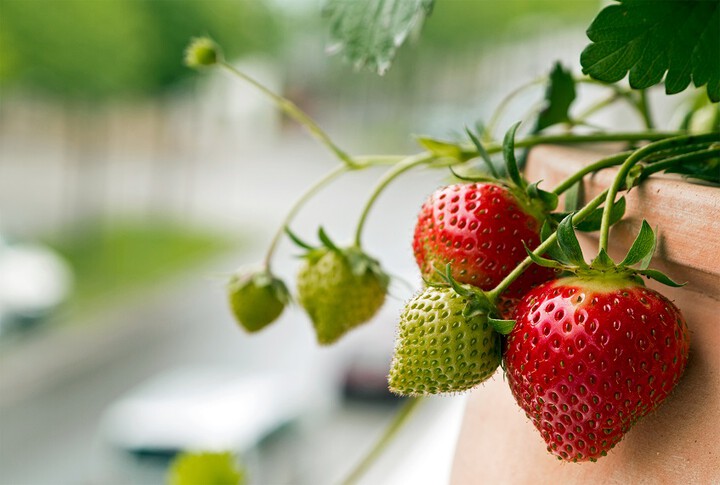There are plenty of gardening opportunities for small space dwellers.

Containers don't have to be filled with impatiens, begonias, and geraniums—though those are all beautiful options if you like them. In the event that you're looking to create planters filled with more unexpected choices, however, you might be pleased to learn that there are many other types of greenery—tall plants and flowers, and even some vegetables and fruits—that can thrive in small spaces.
Here are seven plants you didn't think could grow in a container—but can (and will grow well).
Sunflowers
Some varieties of sunflowers are much smaller than their tallest cousins—making them the ideal flowers for containers, says Marlee Cooper, the seasonal plant expert at Urban Jungle in Philadelphia. For example, "Music Box" sunflowers grow only 18-inches tall, and need just 8 to 10 inches of soil to survive; "Big Smile" sunflowers grow just 15 inches tall, and they can easily share space with other plants. "These varieties grow as annuals and would pair well with other shallow root annuals, like lobelia or spreading petunias, that will add textures and colors to your containers," says Cooper. "Or, you could add greens like spinach or leaf lettuce if you want to save the sunflower seeds and make it an edible container."
Peace Lily
While many people keep their peace lily indoors, it can also grow outside in containers. "It's a bold plant for adding drama to shaded decks, patios, porches, and other spaces," says Justin Hancock, horticulturist for Costa Farms. These flowers grow about 8 inches tall and can spread to 4-feet long. A peace lily does best in temperatures of 50 degrees or higher, and "likes to be watered as the top inch or so of the potting mix dries to the touch," he says.
Figs
Figs, such as the "Petite Negra" variety, thrive in containers—when they are "given a sunny spot outside and well-draining soil," says Cooper. In fact, these figs can produce a lot of fruit and grow only a foot tall. However, these figs grow best outside in USDA Zones 8 through 10—the warmest, sunniest spots in the country. And so, if you're growing them in a cooler region, Cooper suggests bringing them in to a sunny windowsill during the winter.
Berries
"Blueberries, strawberries, and raspberries can be grown in containers," Cooper says. For strawberries, however, Cooper says that you'll want to use a hanging container, such as a hanging basket, to keep fresh fruit off the ground. And while all blueberries can do well in containers, some will truly flourish in them: "Native varieties of blueberries are especially hardy, and they will support your native pollinators and insects as well," Cooper explains.
Related: Eight Subscription Services That Deliver Plants Right to Your Front Door
Prayer Plant
According to Hancock, prayer plants are "one of the trendiest indoor plants right now." But take it outside, in a container, "and you'll see it explode in lush growth," he says, adding you can "grow it on its own in a container or combine it with other shade-loving plants to create unique looks that will make you friends jealous." They do best in warm temperatures—and should be watered whenever the top inch of their soil begins to feel dry, Hancock instructs.
Orchid Cactus
Though these cacti grow natively in the rainforest, they also thrive in containers, thanks to their shallow root systems and responsiveness to crowding, says Cooper. "They'll spill over the edge of your container and provide gorgeous blooms that will blow you away," Cooper says. To help them grow, plant these cacti in containers with well-draining soil, and place them in a shady spot. Like figs, if you live somewhere with cooler weather, bring them in during the winter months, keeping them in a bright windowsill until the next year, she says.
Vegetables
"Many people believe if you only have the space to do container gardening, then it's nearly impossible to grow veggies," says Cooper, "But that is a large misconception." Some veggies, such as spinach, arugula, and sprouts, have shallow root systems that thrive in containers, she explains, while "cold crops like broccoli and cabbage are compact, which makes them a great choice for a pot that has around 10 inches of depth." Even root vegetables, such as radishes, carrots, and beets can grow well in containers. These just need "about a foot of depth and 3 to 4 inches of spacing," she says, "and you'll have delicious veggies in no time."